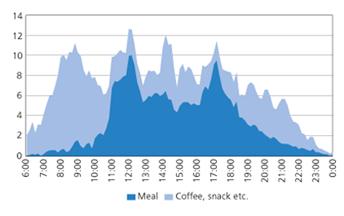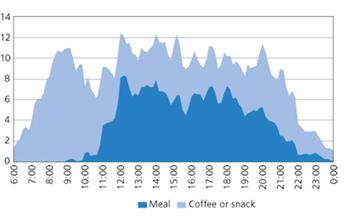Where and when do we eat?
- Time Use Survey data on eating out
- Looser patterns of mealtimes on weekends
- Eating alone and with others
- Occasions for eating out
- Less time spent at restaurants
- Income, age, attitudes and restaurant supply play a role in eating out
Koko dokumentti yhdell� sivulla
Looser patterns of mealtimes on weekends
The pattern of meals has changed somewhat over the last few decades. On weekdays, the schedule of mealtimes is kept to a regular rhythm by eating at work, at a student restaurant or at school – similarly to our other daily rhythms. On the other hand, a major change has taken place in our eating patterns during the weekend. While we still had clear-cut lunch and dinner times in the late 1980s, all this had gone out the window by the turn of the millennium. The latest studies indicate that this change has been permanent. There is no consistent pattern, and we all have lunch or dinner whenever it suits us. Some of these meals are taken at restaurants, some at home. The share of snacks seems to have increased. This may indicate that we have become accustomed to only having a single proper meal on weekends. Breakfast and, to some extent, evening snacks stand out in the daily pattern, but otherwise somebody always seems to be snacking at any given time of the day. Figures 3 and 4 describe the pattern of mealtimes on Saturdays. The pattern for Sundays is rather similar to Saturdays.
Figure 3. Pattern of meals on Saturdays in 1987−1988. The share of respondents who were having a meal.

Source: Statistics Finland. Time Use Survey.
Figure 4. Pattern of meals on Saturdays in 2009−2010. The share of respondents who were having a meal.

Source: Statistics Finland. Time Use Survey.
The figures describe having a meal as the main activity, meaning that the person keeping a time use diary has specified eating as the primary activity rather than, for example, social interaction that may take place over a meal. We also analysed the time use data to discover how often eating had been recorded as a secondary activity. It turned out that having a meal was rarely a secondary activity, while having coffee or some other snack was entered as a secondary activity quite often, especially in the morning, when it was combined with reading the paper, and in the afternoon, when it may have been combined with work or social interaction. Men recorded eating as a secondary activity more often than women.
P�ivitetty 20.3.2013
